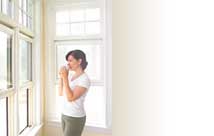Window Replacement: Shape up your home energy savings
| Tweet |
Many energy makeovers start with investigating old windows and doors. Nearly 26 percent of homeowners say what the most dislike about their existing windows and doors is that they are drafty or inefficient, according to a study commissioned by JELD-WEN, a leading manufacturer of windows and doors and a 2010 Energy Star Partner of the Year. As outside temperatures rise in summer and dip in winter, homeowners notice that these inefficiencies quickly turn into high energy bills.
As much as half of the energy used in a home goes toward heating and cooling, according to the U.S. Department of Energy. To minimize the energy and dollars spent to cool a home in summer and heat it during the winter, it's essential that windows and doors are energy efficient.
"Energy efficient windows and doors are crucial to maintaining a home's comfort all year," says Brian Hedlund of JELD-WEN. "Homeowners who replace single-pane glass windows with Energy Star qualified products can plan to save $125 to $450 on energy costs annually, depending on the region of their country, according to the U.S. Department of Energy."
In 2010, new windows and doors can also be efficient for your taxes. With the 30 percent federal tax credit, homeowners have even more incentive to replace older, inefficient products with high-performing models. Federal tax credits for qualified energy efficiency improvements, including windows and doors, are available for up to $1,500. Specific requirements and more information about which JELD-WEN products qualify for the tax credits can be found at www.jeld-wen.com/taxcredit.
To maximize a home's energy efficiency, consider these handy tips:
Start at the front.
A home's front door can play a vital role as one of the first lines of defense against the elements. If a door does not close properly or lets in a draft, a homeowner's utility bills can pay the price. Homeowners should check the weather-stripping and any gaps around the door that can let heat escape. If these features cannot be easily fixed, it may be time to replace the door.
Glass matters.
Choosing windows with insulated Low-E glass is an important step in making a room more energy efficient because the special coating helps reflect some of the interior heat back into the home. These double-pane windows also greatly enhance energy efficiency, compared to single-pane windows.
Vinyl windows have become exceedingly popular because of their low maintenance and energy efficient features. For homeowners who prefer wood windows, manufacturers like JELD-WEN have introduced "pocket" replacement windows that come with Low-E glass and are designed for installation into existing window frames, which makes the process simpler, quicker and less damaging to a home's structure.
Drive home efficiency.
The garage is often forgotten when it comes to energy efficiency, but it's one of the largest entry points of the home. The temperature of a garage greatly affects the overall temperature of the entire home. For energy savings in the garage, find a proper-fitting garage door and make sure that the door leading from the garage to the inside of the home is also energy efficient.
Energy efficiency pays off.
Beyond the initial purchase price of a product, consider the long-term value that energy efficient products offer in terms of annual measurable savings. Homeowners who make energy efficient updates to their home, including windows and doors, can qualify for up to $1,500 in federal tax credits if installed by Dec. 31.
For more information about energy efficient windows and doors, visit JELD-WEN.com or call (800) 877-9482.
Courtesy of ARAcontent.


|
Respond Home Improvement Directory lists the top Replacement Window Contractors in your area, organized by specialty and office location. |
| Top Cities | |
|
Atlanta
Chicago New York |
Los Angeles
Philadelphia Washington DC |
| Canadian Cities | |
|
Calgary
Edmonton Ottawa |
Toronto
Vancouver Winnipeg |





